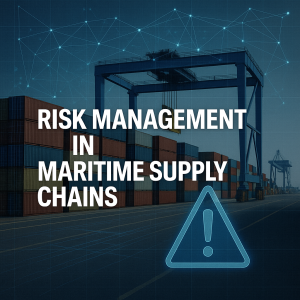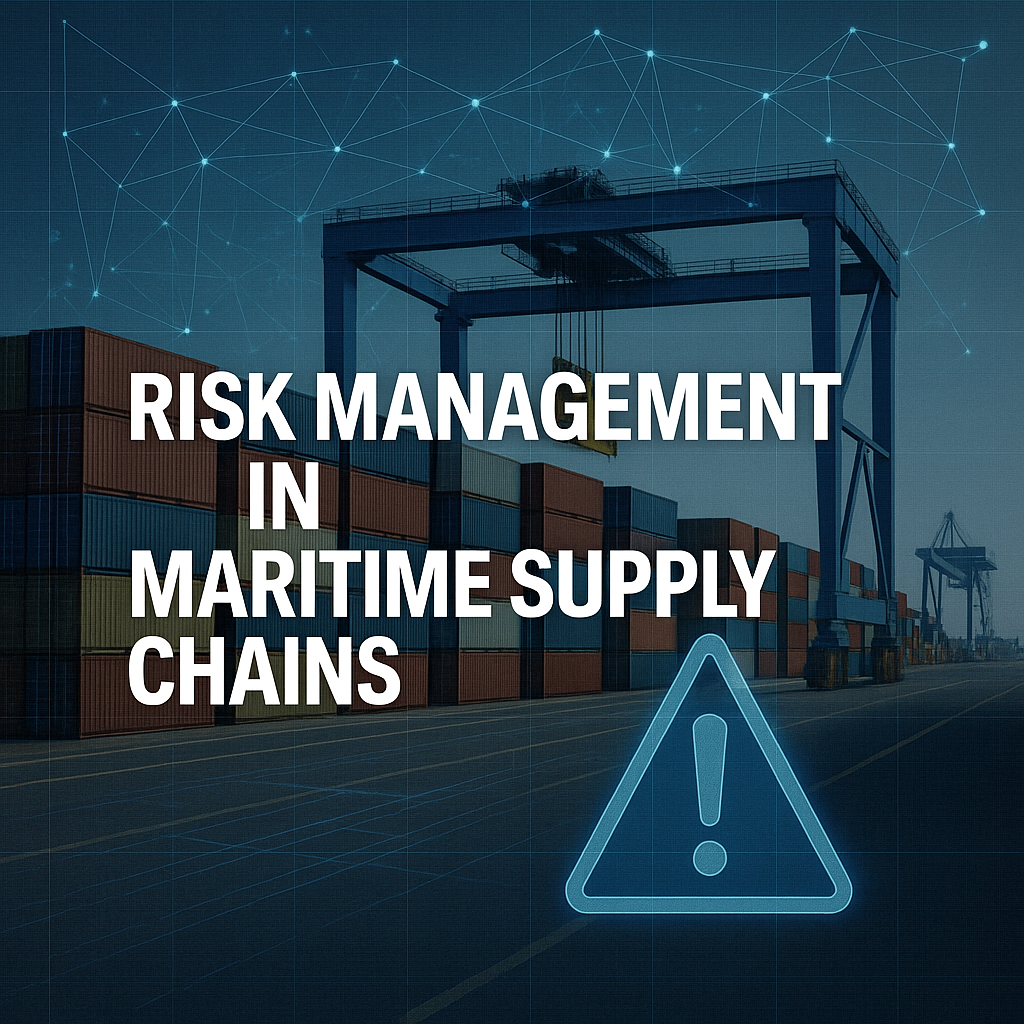
Discover how global shipping and supply chains manage risks from pandemics, geopolitical instability, strikes, and natural disasters. Learn strategies, case studies, and future solutions shaping maritime resilience.
The Storm Beneath the Surface 🌊
In March 2020, when the COVID-19 pandemic shut down factories in China and ports across Europe, the ripple effects reached every corner of global trade. Supermarket shelves stood empty, ship crews were stranded at sea, and freight rates skyrocketed. The shock exposed what maritime professionals had long known: supply chains are only as strong as their weakest link.
For an industry responsible for moving around 80–90% of world trade by volume (UNCTAD, 2023), understanding and managing risk is no longer optional—it is survival. Whether it is a pandemic, geopolitical tensions in the Strait of Hormuz, dockworker strikes in Los Angeles, or cyclones battering South Asian ports, supply chain disruptions can reshape economies overnight.
This article explores how risk management is evolving in the maritime supply chain. We’ll trace the main sources of disruption, the technologies and frameworks helping companies adapt, and the lessons drawn from real-world crises. Above all, we’ll ask: How can shipping prepare for a future where disruption is the norm, not the exception?
Why Risk Management Matters in Maritime Supply Chains
The High Stakes of Disruption
Maritime trade is not just about ships and cargo—it is the lifeline of modern society. Consider:
-
Global food security depends on uninterrupted grain shipments from the Black Sea and North America.
-
Energy markets rely on LNG carriers and oil tankers navigating chokepoints like the Suez Canal and Strait of Malacca.
-
Manufacturing hinges on just-in-time delivery of semiconductors and raw materials.
When disruptions strike, the consequences cascade. A single container stuck at a port can hold parts for thousands of cars. A port shutdown can cost billions in lost trade. According to the World Bank (2022), logistics disruptions during COVID-19 alone reduced global GDP growth by up to 1% annually.
The Visibility Problem
Historically, once cargo left a factory or shipyard, it became almost invisible until reaching its destination. This opacity meant risks were often reactive, discovered only after damage was done. Today, risk management means moving from reaction to prediction.
Key Sources of Supply Chain Disruptions
Pandemics: Lessons from COVID-19
The pandemic revealed vulnerabilities at every layer: crew changes were blocked, ports implemented sudden quarantines, and inland transport halted. At its peak in 2021, congestion at U.S. West Coast ports delayed up to 80 ships at anchor (Lloyd’s List Intelligence, 2021).
Geopolitical Instability
From Russia’s invasion of Ukraine to U.S.–China trade tensions, geopolitics constantly reshapes shipping.
- The closure of Black Sea ports in 2022 disrupted grain exports feeding Africa and the Middle East.
- Sanctions on Russia forced tankers to reroute, shifting oil flows and creating “dark fleets” of older ships.
- The South China Sea disputes threaten vital trade corridors for electronics and manufactured goods.
Strikes and Labor Unrest
Labor actions at ports can cripple supply chains overnight. In 2022, dockworker strikes at Felixstowe (UK’s largest container port) delayed nearly 45% of Britain’s container imports (British Ports Association). Similar risks persist across Los Angeles, Hamburg, and Durban.
Natural Disasters and Climate Change
Hurricanes in the Gulf of Mexico, typhoons in Asia, and rising sea levels challenge maritime infrastructure. The 2011 Japanese tsunami not only destroyed ports but also cut off global electronics and automotive supply chains. Today, climate change increases both the frequency and severity of such disruptions (IPCC, 2023).
Cybersecurity Threats
While less visible, digital disruptions are equally dangerous. The 2017 NotPetya cyberattack shut down Maersk’s operations, costing the company $300 million (Maersk Annual Report, 2018). With increasing reliance on digital systems, supply chains face a growing cyber risk landscape.
Tools and Strategies for Risk Management
Building Resilient Networks
Instead of “just-in-time,” many companies are adopting “just-in-case” models, holding buffer stocks and diversifying suppliers. While more expensive, this approach offers insurance against shocks.
Technology Enablers
- Digital Twins simulate supply networks, predicting the ripple effects of disruptions.
- AI-driven analytics forecast port congestion and geopolitical risks.
- Blockchain secures documentation, reducing fraud and delays.
- IoT sensors track perishable or hazardous cargo in real time, reducing spoilage and safety risks.
Regulatory and Institutional Frameworks
- The IMO’s Facilitation Convention (FAL) promotes smoother documentation flows, critical during crises.
- Paris MoU and Port State Control regimes enforce safety standards, reducing accident-related disruptions.
- ILO Maritime Labour Convention (MLC, 2006) ensures seafarer welfare, reducing risks from strikes or forced labor issues.
Insurance and Financial Tools
P&I Clubs and insurers now offer business interruption coverage tailored to pandemics and cyber risks. This financial cushioning allows operators to survive shocks without collapsing.
Case Studies: Risk Management in Action 🚢
COVID-19 and Crew Change Crisis
Over 400,000 seafarers were stranded at sea in 2020 due to travel restrictions (IMO, 2021). Companies adapted by creating “crew change hubs” in ports like Singapore and Rotterdam, showing the importance of coordinated international frameworks.
The Suez Canal Blockage (Ever Given, 2021)
When the Ever Given lodged across the canal, it blocked 12% of global trade for six days. Real-time tracking tools like MarineTraffic allowed companies to identify which of their cargoes were affected and reroute accordingly. This incident accelerated investment in alternative routes and digital scenario planning.
Russia–Ukraine Conflict
The war disrupted grain and energy exports, forcing rapid creation of the Black Sea Grain Initiative under the UN. It highlighted how geopolitical risk management now requires diplomatic and logistical cooperation on an unprecedented scale.
Challenges in Risk Management
Cost vs. Resilience
Balancing cost efficiency with resilience remains the hardest challenge. Many firms hesitate to invest in redundancy until disaster strikes.
Coordination Across Stakeholders
Ports, carriers, shippers, and regulators often work in silos. Without shared platforms, risk information is delayed or lost.
Data Quality and Transparency
Digital tools are only as strong as their inputs. Inaccurate AIS data, hidden sanctions-violating fleets, or manipulated emissions reports can undermine trust.
Future Outlook: A Riskier but Smarter World
The next decade will likely see more frequent disruptions driven by climate change, shifting geopolitics, and rising digital threats. Yet supply chains will also become smarter and more adaptive:
-
AI + Big Data will forecast disruptions with increasing accuracy.
-
Decarbonisation pressures (IMO 2050 strategy) will intertwine with risk management, as companies seek both resilience and sustainability.
-
Regionalisation of trade may reduce exposure to global chokepoints but increase complexity in fragmented networks.
-
Collaborative platforms like the IMO’s GISIS and EU’s TEN-T digital corridors will drive shared situational awareness.
FAQ: Risk Management and Supply Chain Disruptions
1. What is the biggest risk facing maritime supply chains today?
Geopolitical instability and climate-related disasters rank highest, though cyber risks are rapidly growing.
2. Can supply chain disruptions be fully prevented?
No. But with proper risk management, their impact can be minimized and recovery accelerated.
3. How do digital twins help in maritime risk management?
They simulate scenarios—such as a port strike or canal closure—allowing companies to test contingency plans before crises occur.
4. Are small shipping companies able to afford these technologies?
Yes, through cloud-based services and shared platforms, SMEs can access tools once reserved for global giants.
5. What role do international regulations play?
Frameworks from the IMO, ILO, and regional authorities set safety, welfare, and reporting standards that reduce systemic vulnerabilities.
6. What lessons did the Suez Canal crisis teach?
That a single chokepoint can paralyze global trade, reinforcing the need for redundancy and digital contingency planning.
7. How do strikes affect maritime trade differently from natural disasters?
Strikes are predictable with negotiation windows, while natural disasters strike suddenly. Both, however, can halt cargo flows entirely.
Conclusion: Sailing Through Uncertainty
Global shipping has always faced storms, but today’s risks are broader, faster, and more interconnected. A pandemic in Asia, a political decision in Washington, or a hurricane in the Caribbean can all ripple through to your local supermarket or shipyard.
The maritime industry is responding with technology, regulation, and new mindsets. From AI-driven visibility to crew welfare protections, the shift is toward resilience, not just efficiency.
For maritime professionals and students, this means learning to navigate not only oceans but also uncertainty. As the world enters an era of constant disruption, risk management is becoming the true compass of global trade.

